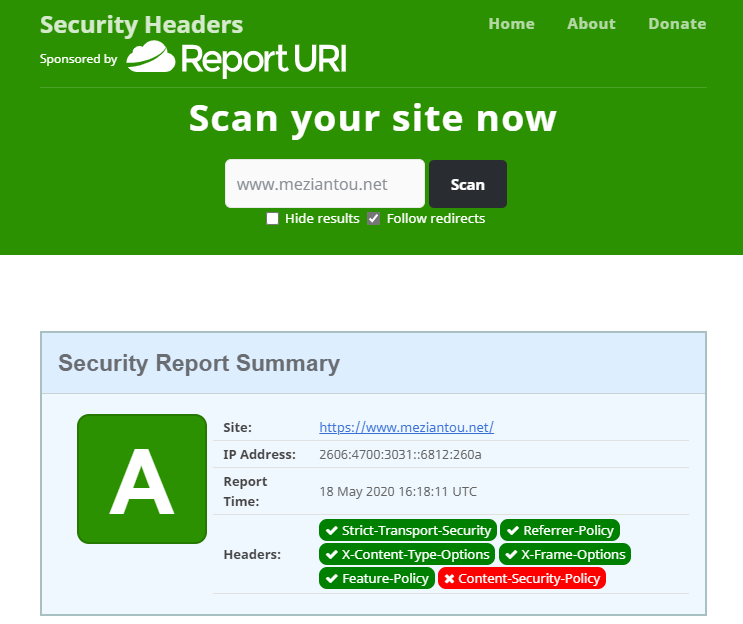##Strict-Transport-Security
HTTP Strict Transport Security (HSTS) protect websites against man-in-the-middle attacks by indicating the browser to access the website using HTTPS instead of using HTTP.
https://developer.mozilla.org/en-US/docs/Web/HTTP/Headers/Strict-Transport-Security
##X-Frame-Options
The X-Frame-Options HTTP response header can be used to indicate whether or not a browser should be allowed to render a page in a <frame>, <iframe>, <embed> or <object>. Sites can use this to avoid clickjacking attacks, by ensuring that their content is not embedded into other sites.
https://developer.mozilla.org/en-US/docs/Web/HTTP/Headers/X-Frame-Options
##X-Permitted-Cross-Domain-Policies
The X-Permitted-Cross-Domain-Policies HTTP response header can be used to indicate whether or not an Adobe products such as Adobe Reader should be allowed to render a page. Sites can use this to avoid clickjacking attacks, by ensuring that their content is not embedded into other applications.
https://www.adobe.com/devnet-docs/acrobatetk/tools/AppSec/xdomain.html
##X-XSS-Protection
The HTTP X-XSS-Protection response header is a feature that stops pages from loading when they detect reflected cross-site scripting (XSS) attacks. Although these protections are largely unnecessary in modern browsers when sites implement a strong Content-Security-Policy that disables the use of inline JavaScript ('unsafe-inline'), they can still provide protections for users of older web browsers that don't yet support CSP.
https://developer.mozilla.org/en-US/docs/Web/HTTP/Headers/X-XSS-Protection
##X-Content-Type-Options
The X-Content-Type-Options response header is a marker used by the server to indicate that the MIME types advertised in the Content-Type headers should not be changed and be followed. This is a way to opt-out of MIME type sniffing, or, in other words, to say that the MIME types are deliberately configured.
https://developer.mozilla.org/en-US/docs/Web/HTTP/Headers/X-Content-Type-Options
##Referrer-Policy
The Referrer-Policy header controls how much referrer information (sent via the Referer header) should be included with requests. This may prevent information disclosure as URLs may contain sensitive data.
https://developer.mozilla.org/en-US/docs/Web/HTTP/Headers/Referrer-Policy
##Feature-Policy
The Feature-Policy header provides a mechanism to allow and deny the use of browser features in its own frame, and in content within any <iframe> elements in the document. It can prevent the use of sensible APIs such as microphone, or it can help to fix performance issues such as using oversized images.
https://developer.mozilla.org/en-US/docs/Web/HTTP/Headers/Feature-Policy
##Expect-CT
The Expect-CT header lets sites opt-in to reporting and/or enforcement of Certificate Transparency requirements, to prevent the use of mis-issued certificates for that site from going unnoticed. This helps detecting man-in-the-middle attacks by someone that could generate a certificate for your domain. Cloudflare has a service to monitor certificate generation: Introducing Certificate Transparency Monitoring
https://developer.mozilla.org/en-US/docs/Web/HTTP/Headers/Expect-CT
##Content-Security-Policy
The Content-Security-Policy response header allows web site administrators to control resources the user agent is allowed to load for a given page. With a few exceptions, policies mostly involve specifying server origins and script endpoints. This helps guard against cross-site scripting attacks (XSS).
https://developer.mozilla.org/en-US/docs/Web/HTTP/Headers/Content-Security-Policy
#ASP.NET Core middleware
In ASP.NET Core, you can set the headers for every request using a middleware. ASP.NET Core provides a middleware to set the HSTS headers when needed and redirecting to https. You'll have to set other security headers manually.
Note that you'll have to adapt the parameters depending on the features your application uses.
C#
public class Startup
{
public void ConfigureServices(IServiceCollection services)
{
services.AddRazorPages();
// Configure HSTS
// https://learn.microsoft.com/en-us/aspnet/core/security/enforcing-ssl?WT.mc_id=DT-MVP-5003978#http-strict-transport-security-protocol-hsts
// https://developer.mozilla.org/en-US/docs/Web/HTTP/Headers/Strict-Transport-Security
services.AddHsts(options =>
{
options.MaxAge = TimeSpan.FromDays(90);
options.IncludeSubDomains = true;
options.Preload = true;
});
// Configure HTTPS redirection
services.AddHttpsRedirection(options =>
{
options.RedirectStatusCode = StatusCodes.Status301MovedPermanently;
options.HttpsPort = 443;
});
}
public void Configure(IApplicationBuilder app, IWebHostEnvironment env)
{
if (!env.IsDevelopment())
{
// HSTS should only be enabled on production, not on localhost
app.UseHsts();
}
// Add other security headers
app.UseMiddleware<SecurityHeadersMiddleware>();
// Redirect http to https
app.UseHttpsRedirection();
app.UseEndpoints(endpoints =>
{
endpoints.MapControllers();
});
}
}
public sealed class SecurityHeadersMiddleware
{
private readonly RequestDelegate _next;
public SecurityHeadersMiddleware(RequestDelegate next)
{
_next = next;
}
public Task Invoke(HttpContext context)
{
// https://developer.mozilla.org/en-US/docs/Web/HTTP/Headers/Referrer-Policy
// TODO Change the value depending of your needs
context.Response.Headers.Add("referrer-policy", new StringValues("strict-origin-when-cross-origin"));
// https://developer.mozilla.org/en-US/docs/Web/HTTP/Headers/X-Content-Type-Options
context.Response.Headers.Add("x-content-type-options", new StringValues("nosniff"));
// https://developer.mozilla.org/en-US/docs/Web/HTTP/Headers/X-Frame-Options
context.Response.Headers.Add("x-frame-options", new StringValues("DENY"));
// https://security.stackexchange.com/questions/166024/does-the-x-permitted-cross-domain-policies-header-have-any-benefit-for-my-websit
context.Response.Headers.Add("X-Permitted-Cross-Domain-Policies", new StringValues("none"));
// https://developer.mozilla.org/en-US/docs/Web/HTTP/Headers/X-XSS-Protection
context.Response.Headers.Add("x-xss-protection", new StringValues("1; mode=block"));
// https://developer.mozilla.org/en-US/docs/Web/HTTP/Headers/Expect-CT
// You can use https://report-uri.com/ to get notified when a misissued certificate is detected
context.Response.Headers.Add("Expect-CT", new StringValues("max-age=0, enforce, report-uri=\"https://example.report-uri.com/r/d/ct/enforce\""));
// https://developer.mozilla.org/en-US/docs/Web/HTTP/Headers/Feature-Policy
// https://github.com/w3c/webappsec-feature-policy/blob/master/features.md
// https://developers.google.com/web/updates/2018/06/feature-policy
// TODO change the value of each rule and check the documentation to see if new features are available
context.Response.Headers.Add("Feature-Policy", new StringValues(
"accelerometer 'none';" +
"ambient-light-sensor 'none';" +
"autoplay 'none';" +
"battery 'none';" +
"camera 'none';" +
"display-capture 'none';" +
"document-domain 'none';" +
"encrypted-media 'none';" +
"execution-while-not-rendered 'none';" +
"execution-while-out-of-viewport 'none';" +
"gyroscope 'none';" +
"magnetometer 'none';" +
"microphone 'none';" +
"midi 'none';" +
"navigation-override 'none';" +
"payment 'none';" +
"picture-in-picture 'none';" +
"publickey-credentials-get 'none';" +
"sync-xhr 'none';" +
"usb 'none';" +
"wake-lock 'none';" +
"xr-spatial-tracking 'none';"
));
// https://developer.mozilla.org/en-US/docs/Web/HTTP/CSP
// https://developer.mozilla.org/en-US/docs/Web/HTTP/Headers/Content-Security-Policy
// TODO change the value of each rule and check the documentation to see if new rules are available
context.Response.Headers.Add("Content-Security-Policy", new StringValues(
"base-uri 'none';" +
"block-all-mixed-content;" +
"child-src 'none';" +
"connect-src 'none';" +
"default-src 'none';" +
"font-src 'none';" +
"form-action 'none';" +
"frame-ancestors 'none';" +
"frame-src 'none';" +
"img-src 'none';" +
"manifest-src 'none';" +
"media-src 'none';" +
"object-src 'none';" +
"sandbox;" +
"script-src 'none';" +
"script-src-attr 'none';" +
"script-src-elem 'none';" +
"style-src 'none';" +
"style-src-attr 'none';" +
"style-src-elem 'none';" +
"upgrade-insecure-requests;" +
"worker-src 'none';"
));
return _next(context);
}
}
#Validation
You can check you have correctly set the security headers by using the following service: https://securityheaders.com

Do you have a question or a suggestion about this post? Contact me!